Impact of Technological Innovations on Management Accounting Practices
VerifiedAdded on 2020/07/23
|9
|2461
|79
Report
AI Summary
This report provides a comprehensive literature review on key innovations in management accounting. It explores the impact of technological advancements on accounting practices, including changes in transaction recording, data analysis, and financial statement disclosure. The review discusses various innovations like accounting software, and their effects on cost management, operational analysis, and decision-making. The report also examines the influence of these innovations on the roles of accounting professionals, emphasizing the need for updated knowledge and skills. Furthermore, it highlights the importance of adapting to these changes to maintain a competitive edge and make effective business decisions. The report also references various theories and principles used in management accounting, such as system theory, contingency theory, and chaos theory. Overall, the report emphasizes the need for businesses to embrace these innovations to improve their financial reporting and achieve their strategic goals, while considering the qualitative aspects of accounting and the impact on employee relations and capital structure.
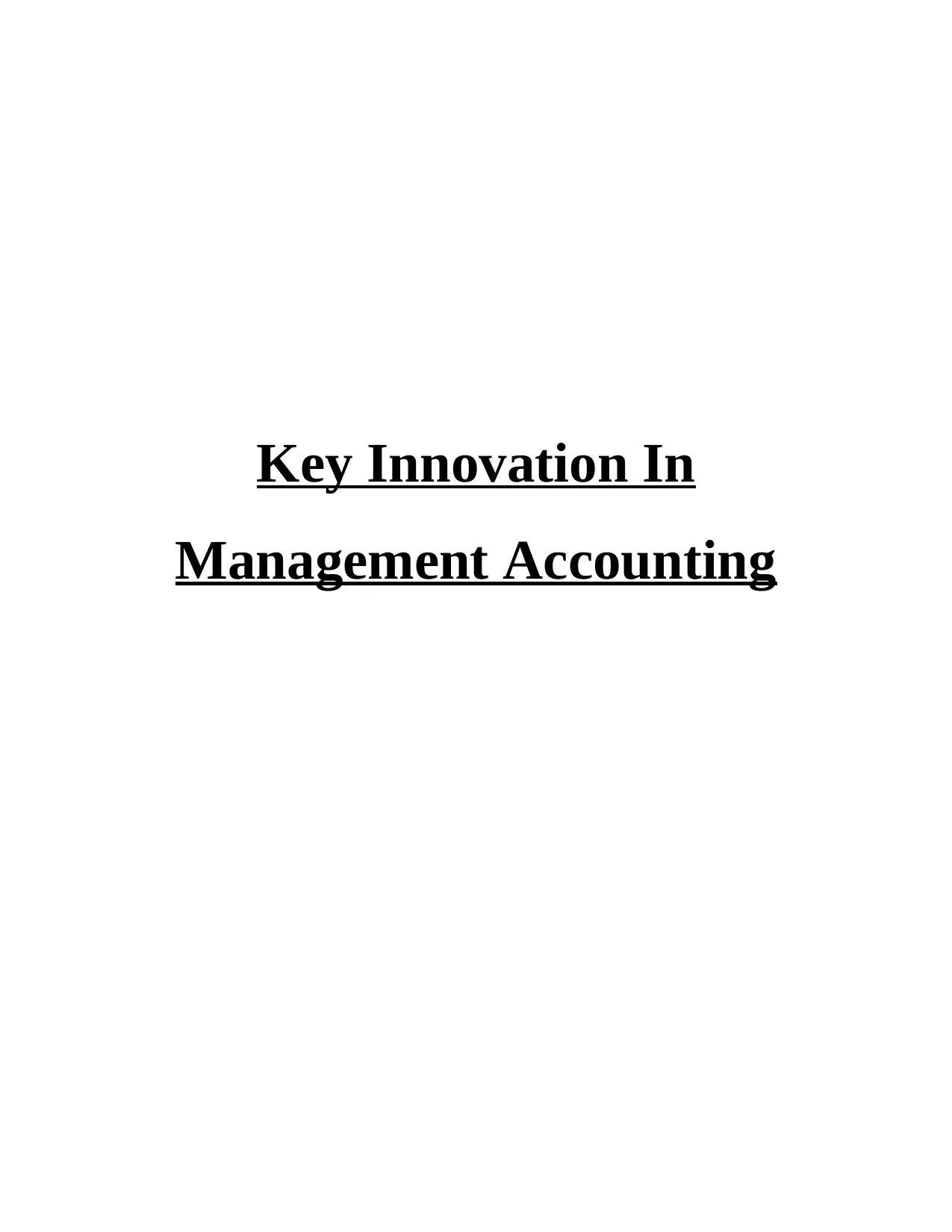
Key Innovation In
Management Accounting
Management Accounting
Paraphrase This Document
Need a fresh take? Get an instant paraphrase of this document with our AI Paraphraser
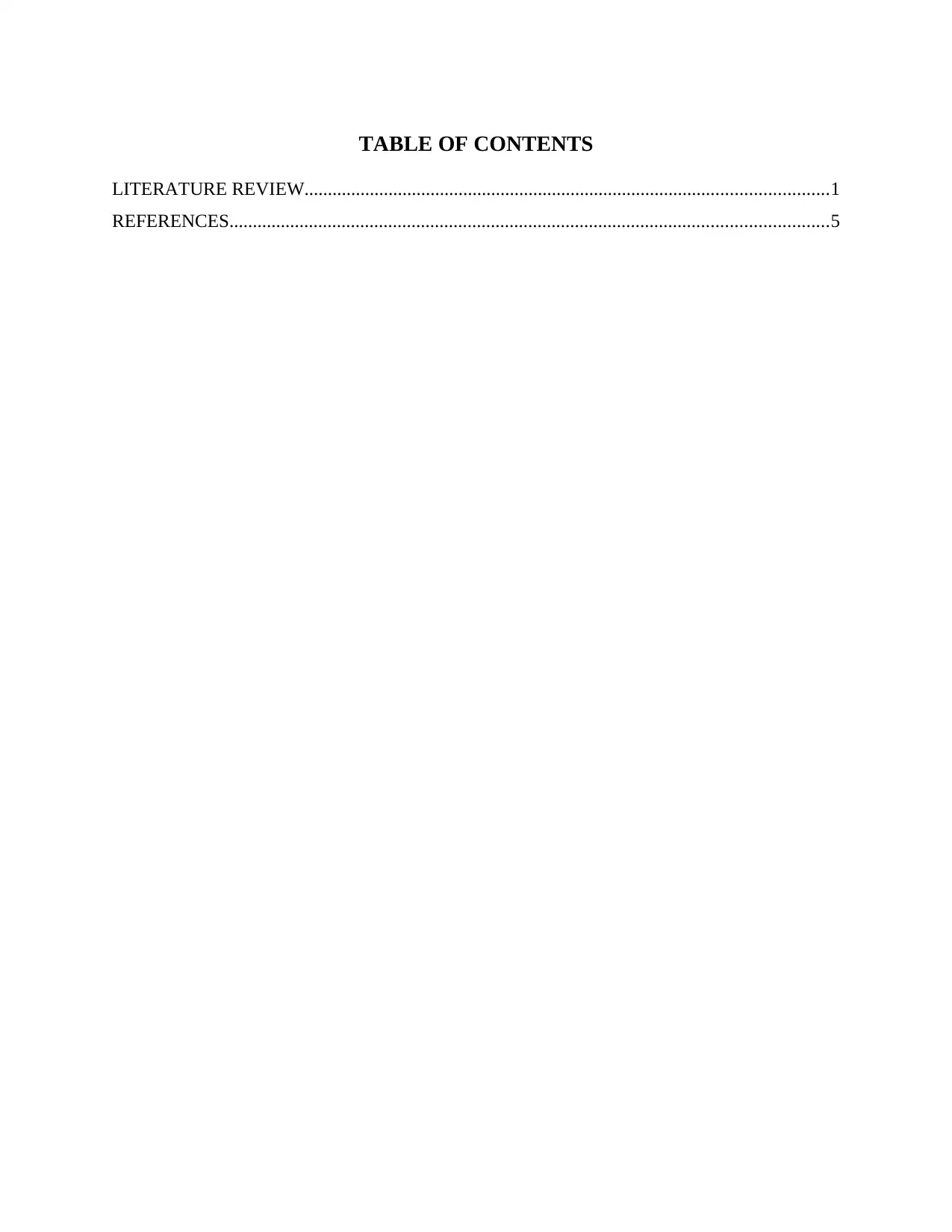
TABLE OF CONTENTS
LITERATURE REVIEW................................................................................................................1
REFERENCES................................................................................................................................5
LITERATURE REVIEW................................................................................................................1
REFERENCES................................................................................................................................5
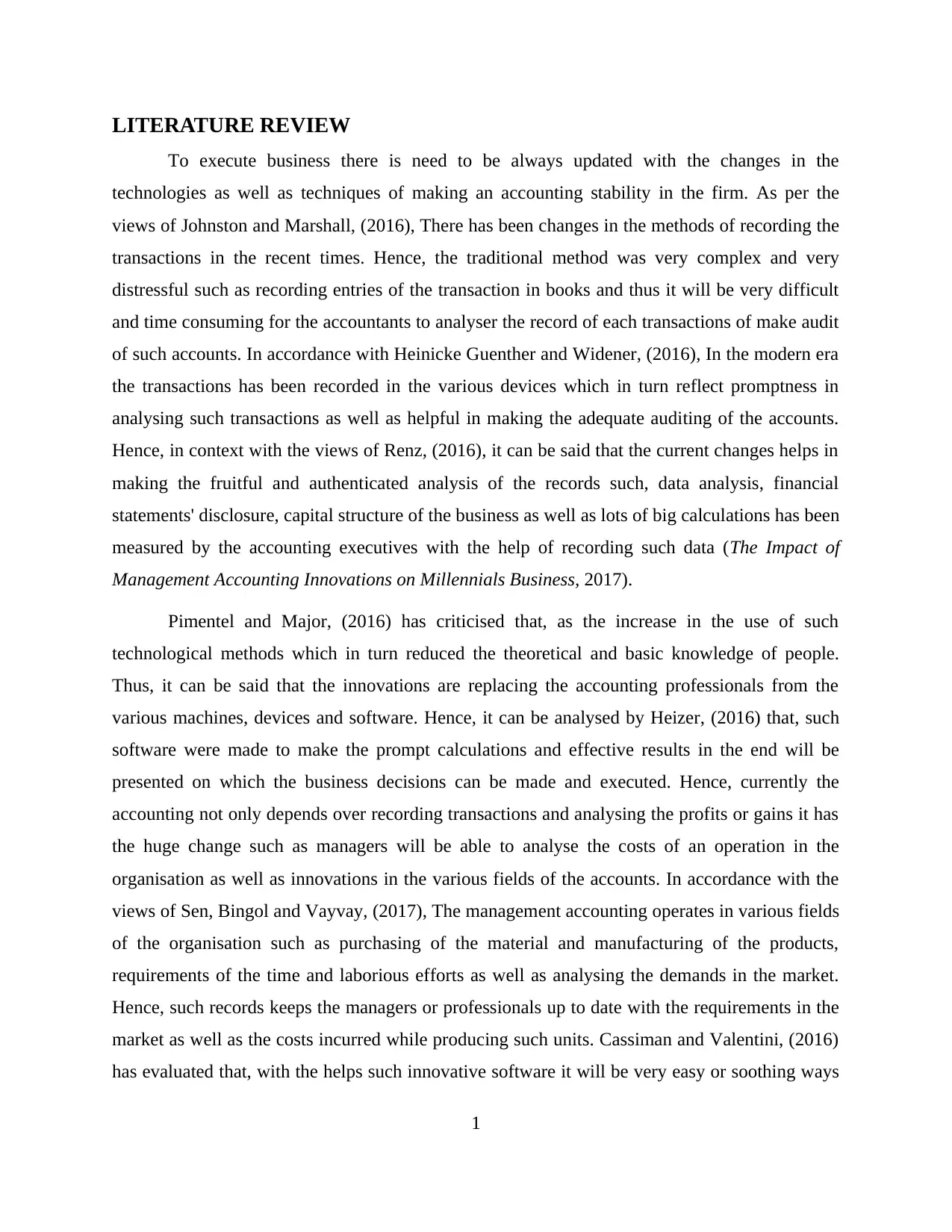
LITERATURE REVIEW
To execute business there is need to be always updated with the changes in the
technologies as well as techniques of making an accounting stability in the firm. As per the
views of Johnston and Marshall, (2016), There has been changes in the methods of recording the
transactions in the recent times. Hence, the traditional method was very complex and very
distressful such as recording entries of the transaction in books and thus it will be very difficult
and time consuming for the accountants to analyser the record of each transactions of make audit
of such accounts. In accordance with Heinicke Guenther and Widener, (2016), In the modern era
the transactions has been recorded in the various devices which in turn reflect promptness in
analysing such transactions as well as helpful in making the adequate auditing of the accounts.
Hence, in context with the views of Renz, (2016), it can be said that the current changes helps in
making the fruitful and authenticated analysis of the records such, data analysis, financial
statements' disclosure, capital structure of the business as well as lots of big calculations has been
measured by the accounting executives with the help of recording such data (The Impact of
Management Accounting Innovations on Millennials Business, 2017).
Pimentel and Major, (2016) has criticised that, as the increase in the use of such
technological methods which in turn reduced the theoretical and basic knowledge of people.
Thus, it can be said that the innovations are replacing the accounting professionals from the
various machines, devices and software. Hence, it can be analysed by Heizer, (2016) that, such
software were made to make the prompt calculations and effective results in the end will be
presented on which the business decisions can be made and executed. Hence, currently the
accounting not only depends over recording transactions and analysing the profits or gains it has
the huge change such as managers will be able to analyse the costs of an operation in the
organisation as well as innovations in the various fields of the accounts. In accordance with the
views of Sen, Bingol and Vayvay, (2017), The management accounting operates in various fields
of the organisation such as purchasing of the material and manufacturing of the products,
requirements of the time and laborious efforts as well as analysing the demands in the market.
Hence, such records keeps the managers or professionals up to date with the requirements in the
market as well as the costs incurred while producing such units. Cassiman and Valentini, (2016)
has evaluated that, with the helps such innovative software it will be very easy or soothing ways
1
To execute business there is need to be always updated with the changes in the
technologies as well as techniques of making an accounting stability in the firm. As per the
views of Johnston and Marshall, (2016), There has been changes in the methods of recording the
transactions in the recent times. Hence, the traditional method was very complex and very
distressful such as recording entries of the transaction in books and thus it will be very difficult
and time consuming for the accountants to analyser the record of each transactions of make audit
of such accounts. In accordance with Heinicke Guenther and Widener, (2016), In the modern era
the transactions has been recorded in the various devices which in turn reflect promptness in
analysing such transactions as well as helpful in making the adequate auditing of the accounts.
Hence, in context with the views of Renz, (2016), it can be said that the current changes helps in
making the fruitful and authenticated analysis of the records such, data analysis, financial
statements' disclosure, capital structure of the business as well as lots of big calculations has been
measured by the accounting executives with the help of recording such data (The Impact of
Management Accounting Innovations on Millennials Business, 2017).
Pimentel and Major, (2016) has criticised that, as the increase in the use of such
technological methods which in turn reduced the theoretical and basic knowledge of people.
Thus, it can be said that the innovations are replacing the accounting professionals from the
various machines, devices and software. Hence, it can be analysed by Heizer, (2016) that, such
software were made to make the prompt calculations and effective results in the end will be
presented on which the business decisions can be made and executed. Hence, currently the
accounting not only depends over recording transactions and analysing the profits or gains it has
the huge change such as managers will be able to analyse the costs of an operation in the
organisation as well as innovations in the various fields of the accounts. In accordance with the
views of Sen, Bingol and Vayvay, (2017), The management accounting operates in various fields
of the organisation such as purchasing of the material and manufacturing of the products,
requirements of the time and laborious efforts as well as analysing the demands in the market.
Hence, such records keeps the managers or professionals up to date with the requirements in the
market as well as the costs incurred while producing such units. Cassiman and Valentini, (2016)
has evaluated that, with the helps such innovative software it will be very easy or soothing ways
1
⊘ This is a preview!⊘
Do you want full access?
Subscribe today to unlock all pages.

Trusted by 1+ million students worldwide
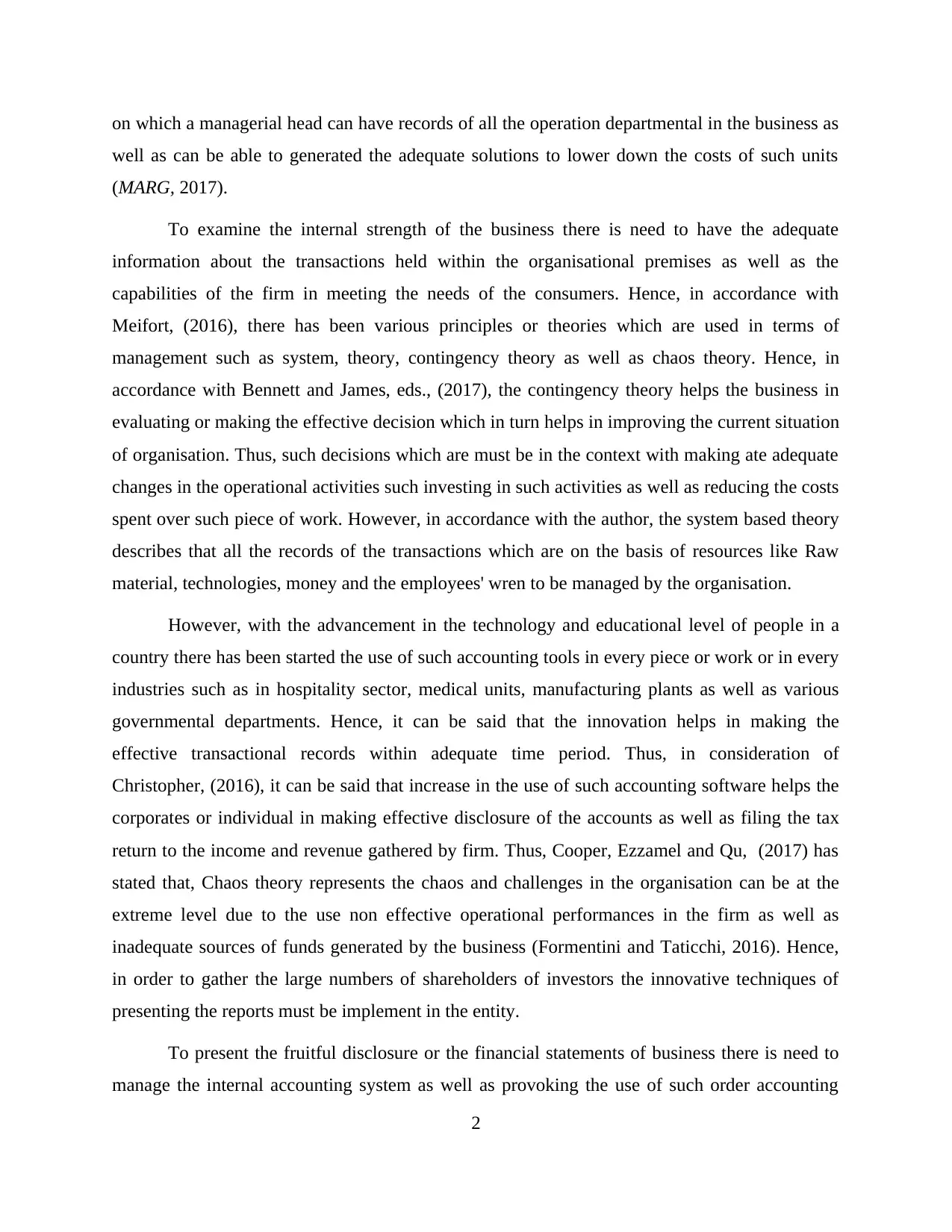
on which a managerial head can have records of all the operation departmental in the business as
well as can be able to generated the adequate solutions to lower down the costs of such units
(MARG, 2017).
To examine the internal strength of the business there is need to have the adequate
information about the transactions held within the organisational premises as well as the
capabilities of the firm in meeting the needs of the consumers. Hence, in accordance with
Meifort, (2016), there has been various principles or theories which are used in terms of
management such as system, theory, contingency theory as well as chaos theory. Hence, in
accordance with Bennett and James, eds., (2017), the contingency theory helps the business in
evaluating or making the effective decision which in turn helps in improving the current situation
of organisation. Thus, such decisions which are must be in the context with making ate adequate
changes in the operational activities such investing in such activities as well as reducing the costs
spent over such piece of work. However, in accordance with the author, the system based theory
describes that all the records of the transactions which are on the basis of resources like Raw
material, technologies, money and the employees' wren to be managed by the organisation.
However, with the advancement in the technology and educational level of people in a
country there has been started the use of such accounting tools in every piece or work or in every
industries such as in hospitality sector, medical units, manufacturing plants as well as various
governmental departments. Hence, it can be said that the innovation helps in making the
effective transactional records within adequate time period. Thus, in consideration of
Christopher, (2016), it can be said that increase in the use of such accounting software helps the
corporates or individual in making effective disclosure of the accounts as well as filing the tax
return to the income and revenue gathered by firm. Thus, Cooper, Ezzamel and Qu, (2017) has
stated that, Chaos theory represents the chaos and challenges in the organisation can be at the
extreme level due to the use non effective operational performances in the firm as well as
inadequate sources of funds generated by the business (Formentini and Taticchi, 2016). Hence,
in order to gather the large numbers of shareholders of investors the innovative techniques of
presenting the reports must be implement in the entity.
To present the fruitful disclosure or the financial statements of business there is need to
manage the internal accounting system as well as provoking the use of such order accounting
2
well as can be able to generated the adequate solutions to lower down the costs of such units
(MARG, 2017).
To examine the internal strength of the business there is need to have the adequate
information about the transactions held within the organisational premises as well as the
capabilities of the firm in meeting the needs of the consumers. Hence, in accordance with
Meifort, (2016), there has been various principles or theories which are used in terms of
management such as system, theory, contingency theory as well as chaos theory. Hence, in
accordance with Bennett and James, eds., (2017), the contingency theory helps the business in
evaluating or making the effective decision which in turn helps in improving the current situation
of organisation. Thus, such decisions which are must be in the context with making ate adequate
changes in the operational activities such investing in such activities as well as reducing the costs
spent over such piece of work. However, in accordance with the author, the system based theory
describes that all the records of the transactions which are on the basis of resources like Raw
material, technologies, money and the employees' wren to be managed by the organisation.
However, with the advancement in the technology and educational level of people in a
country there has been started the use of such accounting tools in every piece or work or in every
industries such as in hospitality sector, medical units, manufacturing plants as well as various
governmental departments. Hence, it can be said that the innovation helps in making the
effective transactional records within adequate time period. Thus, in consideration of
Christopher, (2016), it can be said that increase in the use of such accounting software helps the
corporates or individual in making effective disclosure of the accounts as well as filing the tax
return to the income and revenue gathered by firm. Thus, Cooper, Ezzamel and Qu, (2017) has
stated that, Chaos theory represents the chaos and challenges in the organisation can be at the
extreme level due to the use non effective operational performances in the firm as well as
inadequate sources of funds generated by the business (Formentini and Taticchi, 2016). Hence,
in order to gather the large numbers of shareholders of investors the innovative techniques of
presenting the reports must be implement in the entity.
To present the fruitful disclosure or the financial statements of business there is need to
manage the internal accounting system as well as provoking the use of such order accounting
2
Paraphrase This Document
Need a fresh take? Get an instant paraphrase of this document with our AI Paraphraser
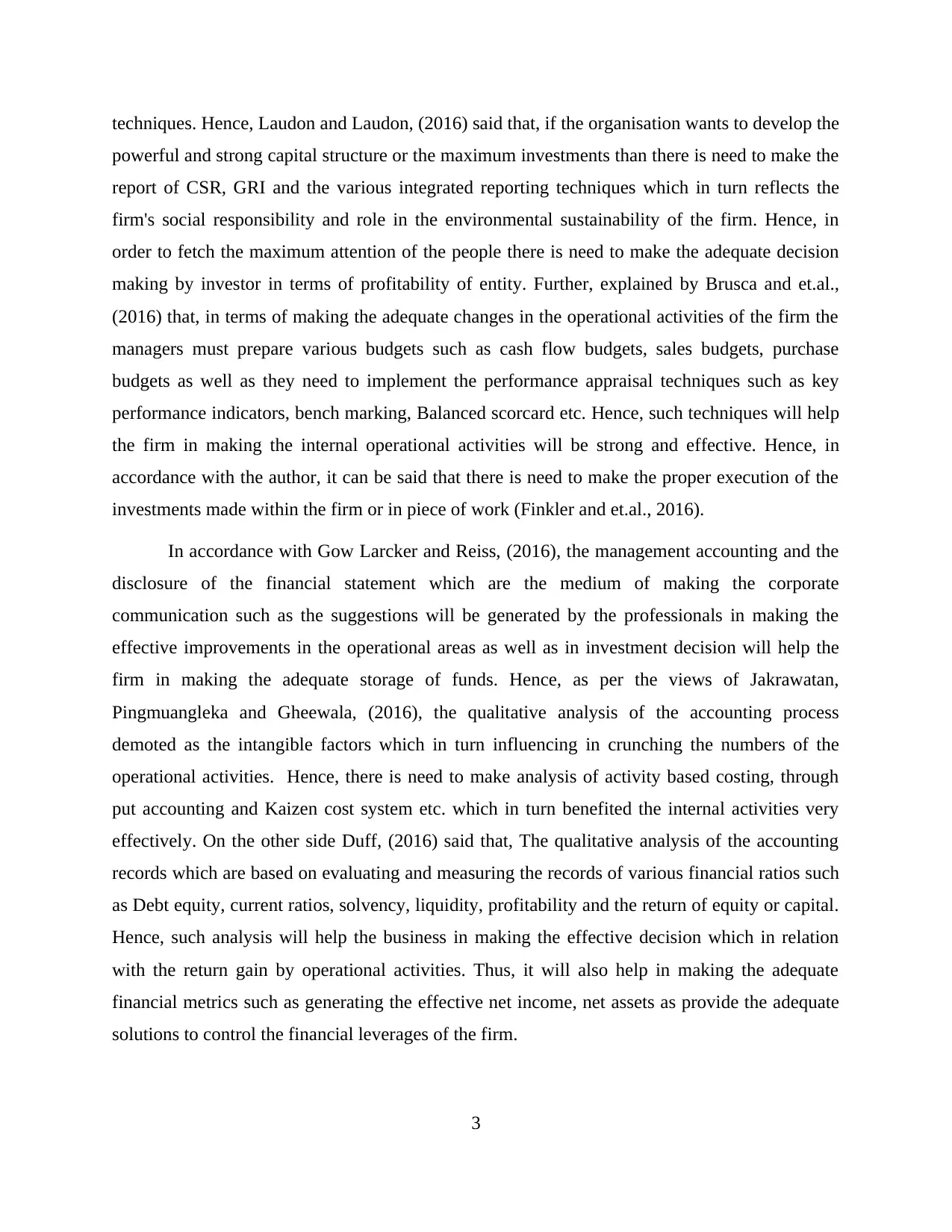
techniques. Hence, Laudon and Laudon, (2016) said that, if the organisation wants to develop the
powerful and strong capital structure or the maximum investments than there is need to make the
report of CSR, GRI and the various integrated reporting techniques which in turn reflects the
firm's social responsibility and role in the environmental sustainability of the firm. Hence, in
order to fetch the maximum attention of the people there is need to make the adequate decision
making by investor in terms of profitability of entity. Further, explained by Brusca and et.al.,
(2016) that, in terms of making the adequate changes in the operational activities of the firm the
managers must prepare various budgets such as cash flow budgets, sales budgets, purchase
budgets as well as they need to implement the performance appraisal techniques such as key
performance indicators, bench marking, Balanced scorcard etc. Hence, such techniques will help
the firm in making the internal operational activities will be strong and effective. Hence, in
accordance with the author, it can be said that there is need to make the proper execution of the
investments made within the firm or in piece of work (Finkler and et.al., 2016).
In accordance with Gow Larcker and Reiss, (2016), the management accounting and the
disclosure of the financial statement which are the medium of making the corporate
communication such as the suggestions will be generated by the professionals in making the
effective improvements in the operational areas as well as in investment decision will help the
firm in making the adequate storage of funds. Hence, as per the views of Jakrawatan,
Pingmuangleka and Gheewala, (2016), the qualitative analysis of the accounting process
demoted as the intangible factors which in turn influencing in crunching the numbers of the
operational activities. Hence, there is need to make analysis of activity based costing, through
put accounting and Kaizen cost system etc. which in turn benefited the internal activities very
effectively. On the other side Duff, (2016) said that, The qualitative analysis of the accounting
records which are based on evaluating and measuring the records of various financial ratios such
as Debt equity, current ratios, solvency, liquidity, profitability and the return of equity or capital.
Hence, such analysis will help the business in making the effective decision which in relation
with the return gain by operational activities. Thus, it will also help in making the adequate
financial metrics such as generating the effective net income, net assets as provide the adequate
solutions to control the financial leverages of the firm.
3
powerful and strong capital structure or the maximum investments than there is need to make the
report of CSR, GRI and the various integrated reporting techniques which in turn reflects the
firm's social responsibility and role in the environmental sustainability of the firm. Hence, in
order to fetch the maximum attention of the people there is need to make the adequate decision
making by investor in terms of profitability of entity. Further, explained by Brusca and et.al.,
(2016) that, in terms of making the adequate changes in the operational activities of the firm the
managers must prepare various budgets such as cash flow budgets, sales budgets, purchase
budgets as well as they need to implement the performance appraisal techniques such as key
performance indicators, bench marking, Balanced scorcard etc. Hence, such techniques will help
the firm in making the internal operational activities will be strong and effective. Hence, in
accordance with the author, it can be said that there is need to make the proper execution of the
investments made within the firm or in piece of work (Finkler and et.al., 2016).
In accordance with Gow Larcker and Reiss, (2016), the management accounting and the
disclosure of the financial statement which are the medium of making the corporate
communication such as the suggestions will be generated by the professionals in making the
effective improvements in the operational areas as well as in investment decision will help the
firm in making the adequate storage of funds. Hence, as per the views of Jakrawatan,
Pingmuangleka and Gheewala, (2016), the qualitative analysis of the accounting process
demoted as the intangible factors which in turn influencing in crunching the numbers of the
operational activities. Hence, there is need to make analysis of activity based costing, through
put accounting and Kaizen cost system etc. which in turn benefited the internal activities very
effectively. On the other side Duff, (2016) said that, The qualitative analysis of the accounting
records which are based on evaluating and measuring the records of various financial ratios such
as Debt equity, current ratios, solvency, liquidity, profitability and the return of equity or capital.
Hence, such analysis will help the business in making the effective decision which in relation
with the return gain by operational activities. Thus, it will also help in making the adequate
financial metrics such as generating the effective net income, net assets as provide the adequate
solutions to control the financial leverages of the firm.
3
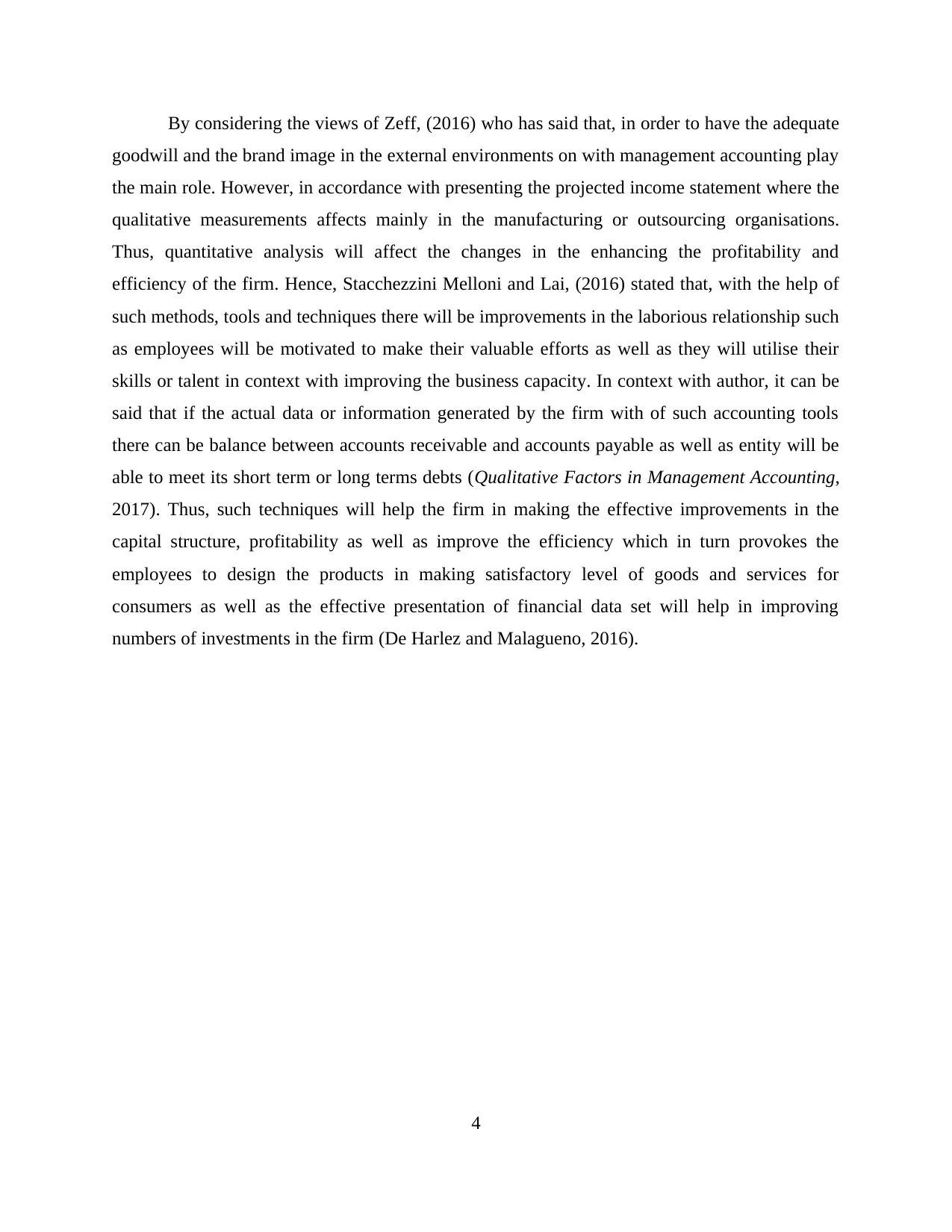
By considering the views of Zeff, (2016) who has said that, in order to have the adequate
goodwill and the brand image in the external environments on with management accounting play
the main role. However, in accordance with presenting the projected income statement where the
qualitative measurements affects mainly in the manufacturing or outsourcing organisations.
Thus, quantitative analysis will affect the changes in the enhancing the profitability and
efficiency of the firm. Hence, Stacchezzini Melloni and Lai, (2016) stated that, with the help of
such methods, tools and techniques there will be improvements in the laborious relationship such
as employees will be motivated to make their valuable efforts as well as they will utilise their
skills or talent in context with improving the business capacity. In context with author, it can be
said that if the actual data or information generated by the firm with of such accounting tools
there can be balance between accounts receivable and accounts payable as well as entity will be
able to meet its short term or long terms debts (Qualitative Factors in Management Accounting,
2017). Thus, such techniques will help the firm in making the effective improvements in the
capital structure, profitability as well as improve the efficiency which in turn provokes the
employees to design the products in making satisfactory level of goods and services for
consumers as well as the effective presentation of financial data set will help in improving
numbers of investments in the firm (De Harlez and Malagueno, 2016).
4
goodwill and the brand image in the external environments on with management accounting play
the main role. However, in accordance with presenting the projected income statement where the
qualitative measurements affects mainly in the manufacturing or outsourcing organisations.
Thus, quantitative analysis will affect the changes in the enhancing the profitability and
efficiency of the firm. Hence, Stacchezzini Melloni and Lai, (2016) stated that, with the help of
such methods, tools and techniques there will be improvements in the laborious relationship such
as employees will be motivated to make their valuable efforts as well as they will utilise their
skills or talent in context with improving the business capacity. In context with author, it can be
said that if the actual data or information generated by the firm with of such accounting tools
there can be balance between accounts receivable and accounts payable as well as entity will be
able to meet its short term or long terms debts (Qualitative Factors in Management Accounting,
2017). Thus, such techniques will help the firm in making the effective improvements in the
capital structure, profitability as well as improve the efficiency which in turn provokes the
employees to design the products in making satisfactory level of goods and services for
consumers as well as the effective presentation of financial data set will help in improving
numbers of investments in the firm (De Harlez and Malagueno, 2016).
4
⊘ This is a preview!⊘
Do you want full access?
Subscribe today to unlock all pages.

Trusted by 1+ million students worldwide
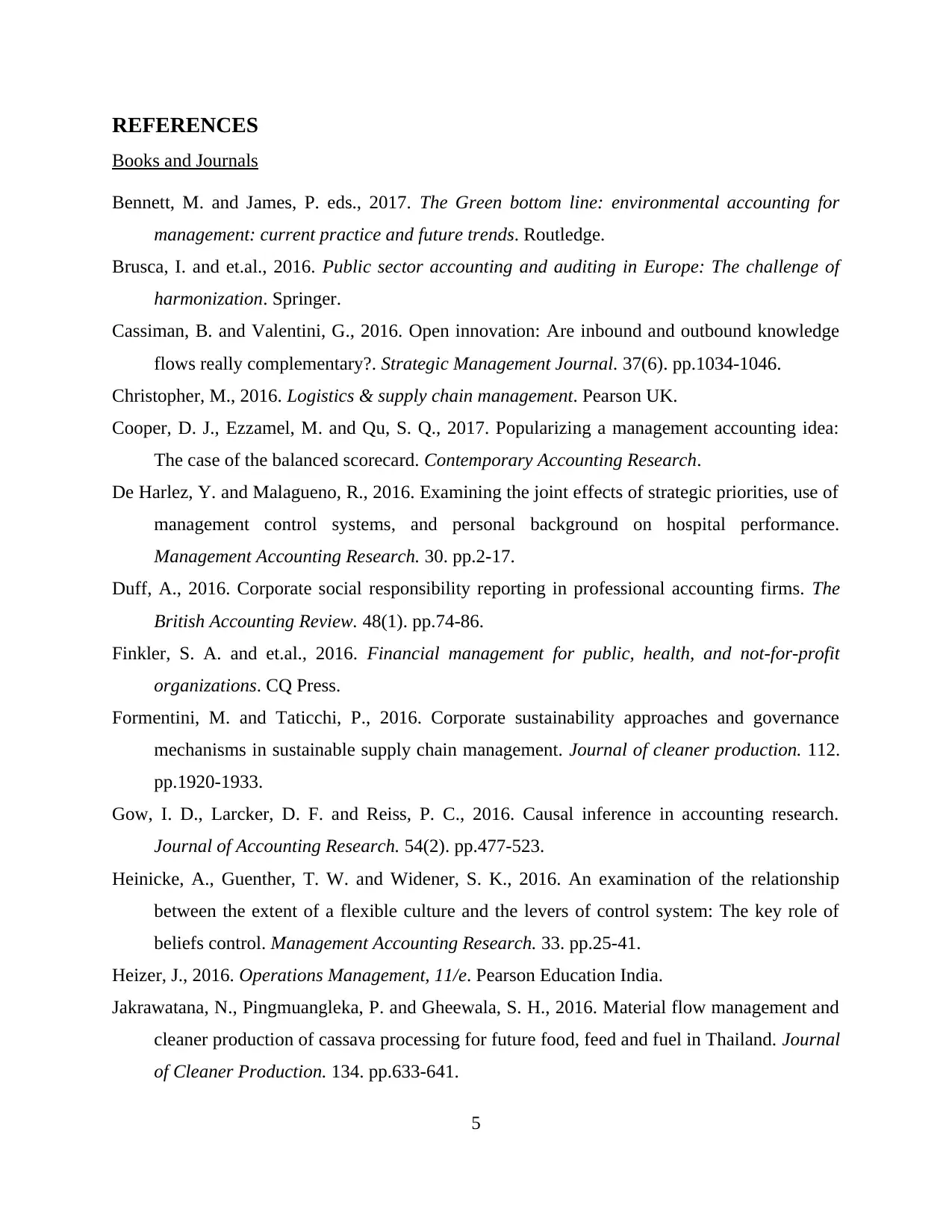
REFERENCES
Books and Journals
Bennett, M. and James, P. eds., 2017. The Green bottom line: environmental accounting for
management: current practice and future trends. Routledge.
Brusca, I. and et.al., 2016. Public sector accounting and auditing in Europe: The challenge of
harmonization. Springer.
Cassiman, B. and Valentini, G., 2016. Open innovation: Are inbound and outbound knowledge
flows really complementary?. Strategic Management Journal. 37(6). pp.1034-1046.
Christopher, M., 2016. Logistics & supply chain management. Pearson UK.
Cooper, D. J., Ezzamel, M. and Qu, S. Q., 2017. Popularizing a management accounting idea:
The case of the balanced scorecard. Contemporary Accounting Research.
De Harlez, Y. and Malagueno, R., 2016. Examining the joint effects of strategic priorities, use of
management control systems, and personal background on hospital performance.
Management Accounting Research. 30. pp.2-17.
Duff, A., 2016. Corporate social responsibility reporting in professional accounting firms. The
British Accounting Review. 48(1). pp.74-86.
Finkler, S. A. and et.al., 2016. Financial management for public, health, and not-for-profit
organizations. CQ Press.
Formentini, M. and Taticchi, P., 2016. Corporate sustainability approaches and governance
mechanisms in sustainable supply chain management. Journal of cleaner production. 112.
pp.1920-1933.
Gow, I. D., Larcker, D. F. and Reiss, P. C., 2016. Causal inference in accounting research.
Journal of Accounting Research. 54(2). pp.477-523.
Heinicke, A., Guenther, T. W. and Widener, S. K., 2016. An examination of the relationship
between the extent of a flexible culture and the levers of control system: The key role of
beliefs control. Management Accounting Research. 33. pp.25-41.
Heizer, J., 2016. Operations Management, 11/e. Pearson Education India.
Jakrawatana, N., Pingmuangleka, P. and Gheewala, S. H., 2016. Material flow management and
cleaner production of cassava processing for future food, feed and fuel in Thailand. Journal
of Cleaner Production. 134. pp.633-641.
5
Books and Journals
Bennett, M. and James, P. eds., 2017. The Green bottom line: environmental accounting for
management: current practice and future trends. Routledge.
Brusca, I. and et.al., 2016. Public sector accounting and auditing in Europe: The challenge of
harmonization. Springer.
Cassiman, B. and Valentini, G., 2016. Open innovation: Are inbound and outbound knowledge
flows really complementary?. Strategic Management Journal. 37(6). pp.1034-1046.
Christopher, M., 2016. Logistics & supply chain management. Pearson UK.
Cooper, D. J., Ezzamel, M. and Qu, S. Q., 2017. Popularizing a management accounting idea:
The case of the balanced scorecard. Contemporary Accounting Research.
De Harlez, Y. and Malagueno, R., 2016. Examining the joint effects of strategic priorities, use of
management control systems, and personal background on hospital performance.
Management Accounting Research. 30. pp.2-17.
Duff, A., 2016. Corporate social responsibility reporting in professional accounting firms. The
British Accounting Review. 48(1). pp.74-86.
Finkler, S. A. and et.al., 2016. Financial management for public, health, and not-for-profit
organizations. CQ Press.
Formentini, M. and Taticchi, P., 2016. Corporate sustainability approaches and governance
mechanisms in sustainable supply chain management. Journal of cleaner production. 112.
pp.1920-1933.
Gow, I. D., Larcker, D. F. and Reiss, P. C., 2016. Causal inference in accounting research.
Journal of Accounting Research. 54(2). pp.477-523.
Heinicke, A., Guenther, T. W. and Widener, S. K., 2016. An examination of the relationship
between the extent of a flexible culture and the levers of control system: The key role of
beliefs control. Management Accounting Research. 33. pp.25-41.
Heizer, J., 2016. Operations Management, 11/e. Pearson Education India.
Jakrawatana, N., Pingmuangleka, P. and Gheewala, S. H., 2016. Material flow management and
cleaner production of cassava processing for future food, feed and fuel in Thailand. Journal
of Cleaner Production. 134. pp.633-641.
5
Paraphrase This Document
Need a fresh take? Get an instant paraphrase of this document with our AI Paraphraser
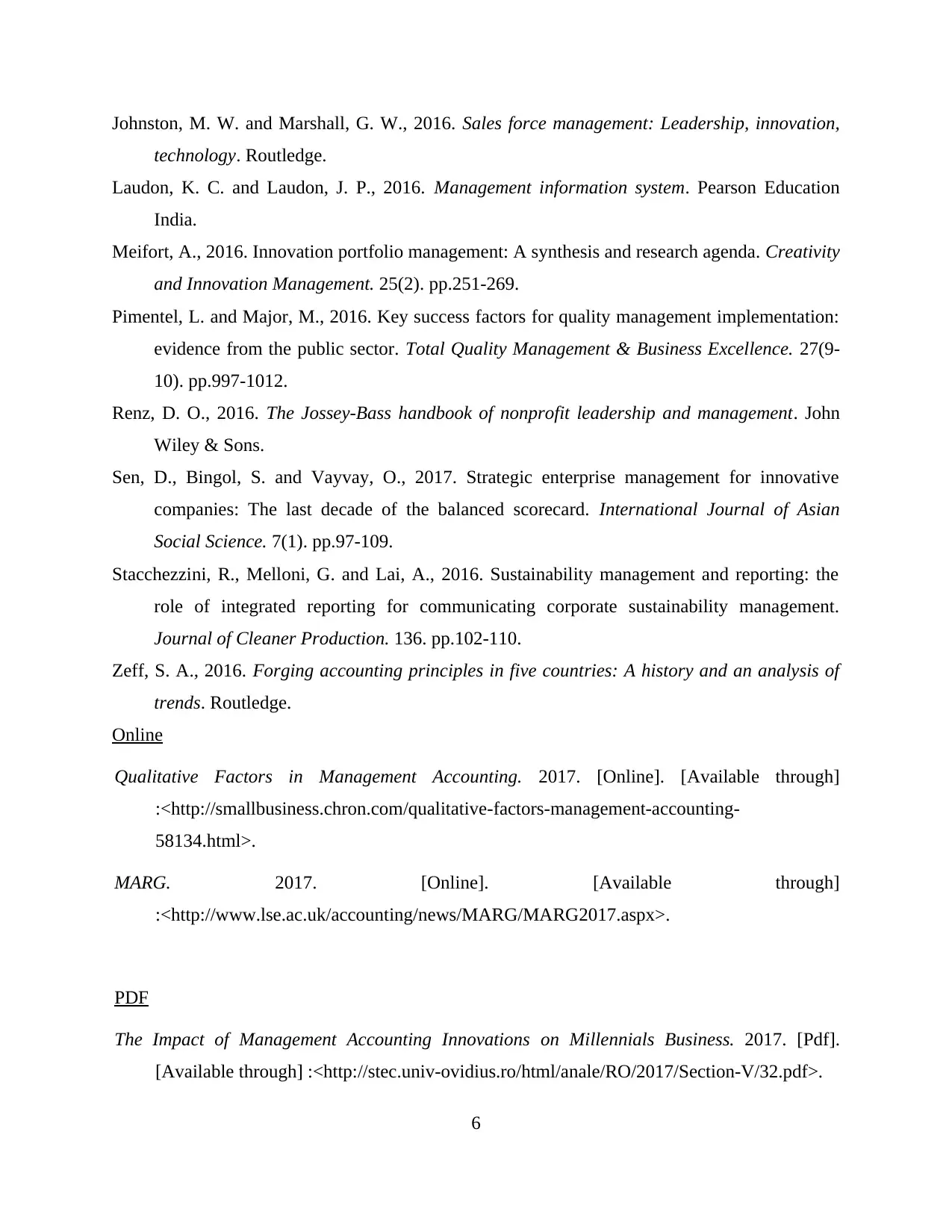
Johnston, M. W. and Marshall, G. W., 2016. Sales force management: Leadership, innovation,
technology. Routledge.
Laudon, K. C. and Laudon, J. P., 2016. Management information system. Pearson Education
India.
Meifort, A., 2016. Innovation portfolio management: A synthesis and research agenda. Creativity
and Innovation Management. 25(2). pp.251-269.
Pimentel, L. and Major, M., 2016. Key success factors for quality management implementation:
evidence from the public sector. Total Quality Management & Business Excellence. 27(9-
10). pp.997-1012.
Renz, D. O., 2016. The Jossey-Bass handbook of nonprofit leadership and management. John
Wiley & Sons.
Sen, D., Bingol, S. and Vayvay, O., 2017. Strategic enterprise management for innovative
companies: The last decade of the balanced scorecard. International Journal of Asian
Social Science. 7(1). pp.97-109.
Stacchezzini, R., Melloni, G. and Lai, A., 2016. Sustainability management and reporting: the
role of integrated reporting for communicating corporate sustainability management.
Journal of Cleaner Production. 136. pp.102-110.
Zeff, S. A., 2016. Forging accounting principles in five countries: A history and an analysis of
trends. Routledge.
Online
Qualitative Factors in Management Accounting. 2017. [Online]. [Available through]
:<http://smallbusiness.chron.com/qualitative-factors-management-accounting-
58134.html>.
MARG. 2017. [Online]. [Available through]
:<http://www.lse.ac.uk/accounting/news/MARG/MARG2017.aspx>.
PDF
The Impact of Management Accounting Innovations on Millennials Business. 2017. [Pdf].
[Available through] :<http://stec.univ-ovidius.ro/html/anale/RO/2017/Section-V/32.pdf>.
6
technology. Routledge.
Laudon, K. C. and Laudon, J. P., 2016. Management information system. Pearson Education
India.
Meifort, A., 2016. Innovation portfolio management: A synthesis and research agenda. Creativity
and Innovation Management. 25(2). pp.251-269.
Pimentel, L. and Major, M., 2016. Key success factors for quality management implementation:
evidence from the public sector. Total Quality Management & Business Excellence. 27(9-
10). pp.997-1012.
Renz, D. O., 2016. The Jossey-Bass handbook of nonprofit leadership and management. John
Wiley & Sons.
Sen, D., Bingol, S. and Vayvay, O., 2017. Strategic enterprise management for innovative
companies: The last decade of the balanced scorecard. International Journal of Asian
Social Science. 7(1). pp.97-109.
Stacchezzini, R., Melloni, G. and Lai, A., 2016. Sustainability management and reporting: the
role of integrated reporting for communicating corporate sustainability management.
Journal of Cleaner Production. 136. pp.102-110.
Zeff, S. A., 2016. Forging accounting principles in five countries: A history and an analysis of
trends. Routledge.
Online
Qualitative Factors in Management Accounting. 2017. [Online]. [Available through]
:<http://smallbusiness.chron.com/qualitative-factors-management-accounting-
58134.html>.
MARG. 2017. [Online]. [Available through]
:<http://www.lse.ac.uk/accounting/news/MARG/MARG2017.aspx>.
The Impact of Management Accounting Innovations on Millennials Business. 2017. [Pdf].
[Available through] :<http://stec.univ-ovidius.ro/html/anale/RO/2017/Section-V/32.pdf>.
6

7
⊘ This is a preview!⊘
Do you want full access?
Subscribe today to unlock all pages.

Trusted by 1+ million students worldwide
1 out of 9
Related Documents
Your All-in-One AI-Powered Toolkit for Academic Success.
+13062052269
info@desklib.com
Available 24*7 on WhatsApp / Email
![[object Object]](/_next/static/media/star-bottom.7253800d.svg)
Unlock your academic potential
Copyright © 2020–2025 A2Z Services. All Rights Reserved. Developed and managed by ZUCOL.




